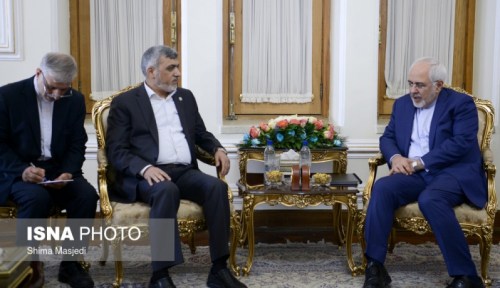The renewed alliance with Hamas will enable Iran to strengthen its zones of influence along Israel’s borders, including within the West Bank where Hamas and Islamic Jihad give it a foothold.
During the first week of August 2017, a delegation from the Hamas Political Bureau visited Iran. The Islamic movement said the visit meant that the sides were opening a “new page” in their relations.1
The delegation was led by Izzat al-Rishk, a senior Hamas official, and included Salah al-Aruri, senior Hamas leader and founding commander of Izz ad-Din al-Qassam Brigades; Zaher Jabarin, Hamas military commander; Osama Hamdan, top representative of Hamas in Lebanon; and Hamas’ representative in Tehran, Khaled al-Kadoummi.2
The delegation met with senior Iranian officials including: Foreign Minister Mohammad Javad Zarif; Chairman of the Parliament Ali Larijani; Senior Adviser to the Supreme Leader in International Affairs Ali Akbar Velayati; Chairman of the Strategic Council on Foreign Relations Kamal Kharazi; and Special Assistant of the Chairman of the Parliament for International Affairs Hossein Amir Abdollahian.

Iranian Foreign Minister Zarif confirms the importance of the relationship with Hamas’ delegation to Tehran.
Iranian-Hamas relations suffered a setback during the civil war in Syria. At first, the Hamas leaders tried to tread carefully between the Shiite-Alawite axis led by Syria, Iran, and Hizbullah and the Sunni mujahideen organizations. However, as the bloody war dragged on and the Shiite-Alawite axis racked up failures, tensions grew between Iran and Hamas as the former demanded that the Palestinian organization clearly take its side. Hamas was forced to move its offices from Damascus and make use of the infrastructure it had built in Turkey.
Now, again, the Iranian regime is telling the Hamas leadership in no uncertain terms that the Islamic movement must make a “correct” strategic decision, consistent with the changing balance of power in the Middle East, and align with Iran, which has become a regional superpower. Its hegemonic status now grounded in the Shiite crescent, which includes Iraq, Yemen, Syria, and Lebanon, Iran is leading the ongoing struggle against Israel.3 In his meeting with Izzat al-Rishk, Parliament Chairman Larijani said that Hamas must draw conclusions from the Middle Eastern developments in recent years, particularly those in Iraq and Syria.4
What Hamas Seeks
During the visit, the Hamas officials presented the following positions:
- Hamas has an interest in fortifying its relations with Iran, Syria, Hizbullah, and Islamic Jihad based on the common denominator of fighting Israel.5
- Iran provides its support for the anti-Israeli struggle both to Shiite organizations like Hizbullah and to Sunni organizations like Hamas and Islamic Jihad. The fact that Iran is waging a campaign against Sunni Muslim forces in Iraq, Syria, Yemen, and other Middle Eastern countries does not – Hamas implied – preclude aligning with it.6
- The basis for Iran’s relations with the Islamic umma [community] in general is the struggle against Israel, the “common enemy.” The threat posed by Israel does not stop at the geographic borders of Palestine; its hatred for humanity and the chaos it sows affect all of the “Arab and Islamic homeland.”7
- Hamas does not interfere in others’ affairs and does not want Palestine to fall prey to disagreements between the countries of the region; instead its goal is to enlist all elements to support the Palestinian issue. 8
By joining the Iranian axis, Hamas reveals its leadership’s order of priority now that Ismail Haniyeh is at the helm. Liberating Palestine takes precedence over the blood-drenched Middle Eastern battles between the Shiite and Sunni axis. Hamas is distancing itself from Saudi Arabia, which regards Iran as a tangible military threat to the Sunni states. Hamas estimates that allying with Tehran can help it fulfill its strategic objectives of taking control of the Palestinian national movement and “liberating Palestine.”
The Hamas leadership views Iran as a rising regional power that is making gains in Iraq, Syria, Lebanon, as well as Yemen, with a growing military force based on a local arms industry, purchases of advanced weaponry from Russia, and the nuclear project.
The entrenchment of the Shiite crescent under direct Iranian hegemony could threaten the stability of the Hashemite regime in Jordan, where the demographic majority is decidedly Palestinian. The Hamas leadership assesses that, in a scenario where Iran makes an effort to undermine Abdullah’s regime, being aligned with Iran will give Hamas an advantage.
From Iran’s standpoint, the renewed alliance with Hamas will enable it to strengthen its zones of influence along Israel’s borders, including within the West Bank where Hamas and Islamic Jihad give it a foothold.
* * *
Notes
1 http://www.irna.ir/ar/News/82624191
2 https://tinyurl.com/ybg2n5cq
3 http://www.irna.ir/ar/News/82618054
4 http://www.irna.ir/ar/News/82624185
5 http://www.irna.ir/ar/News/82624185
6 http://www.irna.ir/ar/News/82618054
7 Palestine newspaper (Gaza), August 10, 2017, p. 4.
8 Ibid.









